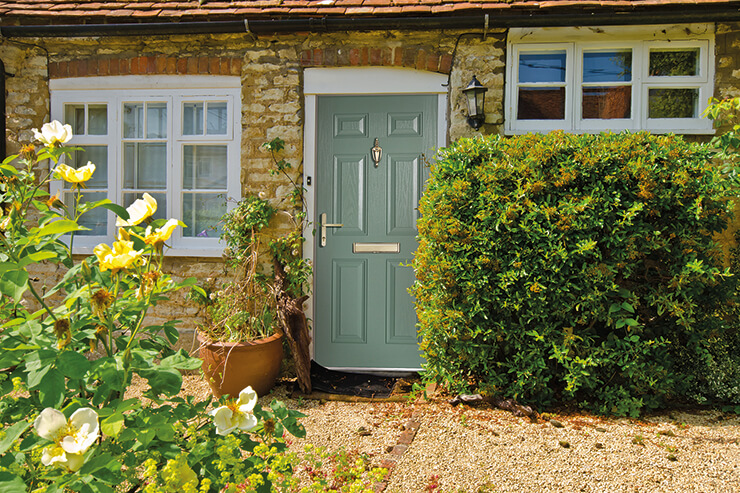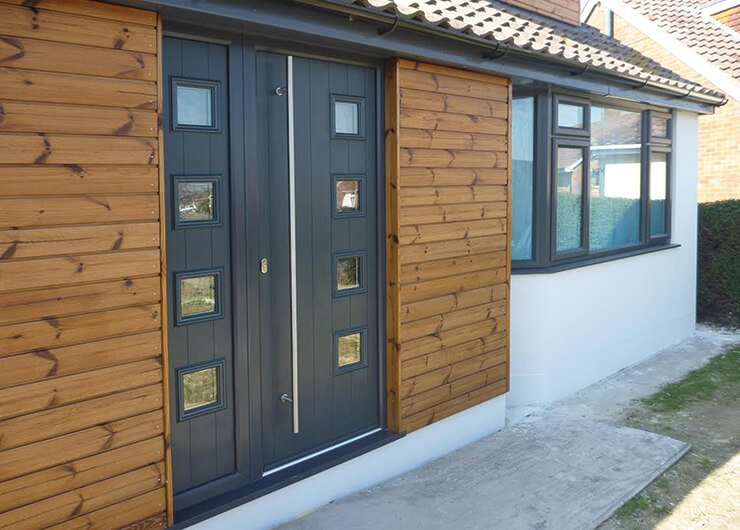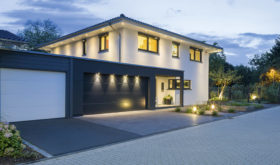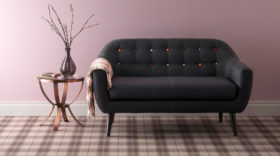
Use code BUILD for 20% off
Book here!
Use code BUILD for 20% off
Book here!Your front door sets the tone for your whole home. It should fit with the overall style of the architecture as well as being secure, highly durable and energy efficient. “It’s the main focus of a house’s approach, so it’s essential to get this element right,” says Elizabeth Assaf from Urban Front.
“A solid unit can provide good service for many years, improving the performance of your building and keeping heat in, not to mention underpinning your home’s security. It will also add a little bit of wow factor and personality to the architecture.”
The fashion is for oversized doors with matching glazed side panels and fanlights (which sit above the door). These dramatic designs make a big impact, which is offset by their minimal detailing: plain planked surfaces; opaque glass; slim ironmongery; and hinge-free pivot opening.
“Doors are getting larger,” says Elizabeth. “We now offer models up to 3.2m tall, which people love – but to be honest, most houses can’t take an oversized version, so the most popular at the moment is a 2.4m by 1.2m unit, on a pivot.”
A modern, minimal design can also work on a smartly updated period property, but in most other cases it’s best to stick with a closer match with the original architecture. Think unglazed, painted, panelled doors for Georgian and early Victorian houses, moving onto increasingly ornate glazed examples (often with stained glass) for later Victorian and Edwardian properties. Farmhouses and rural conversions tend to suit unpainted wood examples that favour craftsmanship over decoration.

At 70mm thick, with triple weather seals, SafeChoice’s Meridian composite door has low U-values (0.91 W/m2K for the glazed version and 0.89 W/m2K for unglazed). Pictured is the Oak model in Chartwell Green, which costs from £1,500 including fitting
“Always choose materials carefully,” says Paul Pennick, timber product manager at MKM Building Supplies. “Ensure the unit suits the function: how will it weather, for example, and which direction does it face? Also, always follow the manufacturer’s installation guidelines to ensure your guarantee remains valid.”
Composite doors are taking over from straight PVCu as the standard high-street offering, mostly because they give great thermal performance and security at a good price (from around £400). They’re made from a steel-reinforced PVCu frame with a wood or foam core, wrapped in a layer of plastic (usually with a woodgrain appearance) for weatherproofing.
“Wood cores give greater solidity security, but foam possibly edges in front in the thermal race,” says Tom Swallow, sales and marketing director at Quickslide. “Over the last year low-density wood composite doors have entered the market, which again helps with the thermal aspect.”
Another advantage over PVCu-only versions is the wide variety of colour options (Quickslide even does a RAL hue-matching service). Make sure the plastic outer layer has a through-colour rather than just a coating, so that any wear and tear will be almost invisible.

The Solidor Milano from Quickslide is a composite product with a timber core. Shown in grey (RAL 7016), prices start from £1,236 including handle (but not the side panel)
Solid wood doors (from around £500) feel heavy and authentic but can be prone to warping and bowing, especially on exposed sites. Look for kiln-dried products and buy from a specialist craftsman who knows which timbers to work with for maximum stability. Engineered/laminated timber doors are sometimes also described as solid wood and their layered construction gives them more stability.
Steel and aluminium are also top-of-the-range options, with the latter being the more premium product as it’s lighter and stronger. Kloeber has just introduced aluminium doors in ready-made sizes (the FunkyFront Euro range), so they are becoming more affordable.
They can be powder-coated in any colour and their insulating foam core ensures they make a good contribution to efficiency (Hormann’s ThermoCarbon door has a U-value of 0.47W/m2K). Expect to pay £1,200 or more for a steel version and at least £1,500 for aluminium.
Insurers usually specify that at least one lock conforms to British Standard BS 3621. For additional protection, look for products with Secured by Design accreditation, which takes into account not just the lock but the quality of the hinges, the materials themselves and the strength of the glass.
Top-end manufacturers offer lots of seductive upgrades to their products for increased security or ease of entry. These include motorised door releases, which operate at the touch of a button on a fob or smartphone, and fingerprint entry (great if you or your teenagers are always losing the keys).
Plain, planked timber doors can work with many architectural styles because they are so simple in their design, but think about what’s happening on the inside of the house, too: do you need glass panes to boost light levels in the hallway? Decorative options, such as stained glass, can beautifully enhance period features in an older property.
On a more contemporary build, meanwhile, side panes and fanlights allow you to play around with design details, such as having an opaque pane with your house number or name picked out in clear glass. As a rule, any glazing in the front door or to the side needs to be made from safety glass.
Photo (top): Oversized entrances set into lots of glazing is the prevailing trend for contemporary homes. These Rondo E80 double doors, £12,576 from Urban Front, offer 11 handle options


Comments are closed.